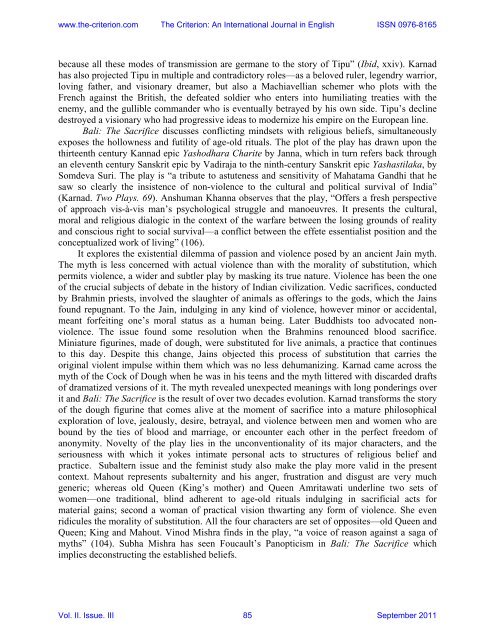Vol. II. Issue. III September 2011 - The Criterion: An International ...
Vol. II. Issue. III September 2011 - The Criterion: An International ...
Vol. II. Issue. III September 2011 - The Criterion: An International ...
Create successful ePaper yourself
Turn your PDF publications into a flip-book with our unique Google optimized e-Paper software.
www.the-criterion.com <strong>The</strong> <strong>Criterion</strong>: <strong>An</strong> <strong>International</strong> Journal in English ISSN 0976-8165<br />
because all these modes of transmission are germane to the story of Tipu” (Ibid, xxiv). Karnad<br />
has also projected Tipu in multiple and contradictory roles—as a beloved ruler, legendry warrior,<br />
loving father, and visionary dreamer, but also a Machiavellian schemer who plots with the<br />
French against the British, the defeated soldier who enters into humiliating treaties with the<br />
enemy, and the gullible commander who is eventually betrayed by his own side. Tipu’s decline<br />
destroyed a visionary who had progressive ideas to modernize his empire on the European line.<br />
Bali: <strong>The</strong> Sacrifice discusses conflicting mindsets with religious beliefs, simultaneously<br />
exposes the hollowness and futility of age-old rituals. <strong>The</strong> plot of the play has drawn upon the<br />
thirteenth century Kannad epic Yashodhara Charite by Janna, which in turn refers back through<br />
an eleventh century Sanskrit epic by Vadiraja to the ninth-century Sanskrit epic Yashastilaka, by<br />
Somdeva Suri. <strong>The</strong> play is “a tribute to astuteness and sensitivity of Mahatama Gandhi that he<br />
saw so clearly the insistence of non-violence to the cultural and political survival of India”<br />
(Karnad. Two Plays. 69). <strong>An</strong>shuman Khanna observes that the play, “Offers a fresh perspective<br />
of approach vis-à-vis man’s psychological struggle and manoeuvres. It presents the cultural,<br />
moral and religious dialogic in the context of the warfare between the losing grounds of reality<br />
and conscious right to social survival—a conflict between the effete essentialist position and the<br />
conceptualized work of living” (106).<br />
It explores the existential dilemma of passion and violence posed by an ancient Jain myth.<br />
<strong>The</strong> myth is less concerned with actual violence than with the morality of substitution, which<br />
permits violence, a wider and subtler play by masking its true nature. Violence has been the one<br />
of the crucial subjects of debate in the history of Indian civilization. Vedic sacrifices, conducted<br />
by Brahmin priests, involved the slaughter of animals as offerings to the gods, which the Jains<br />
found repugnant. To the Jain, indulging in any kind of violence, however minor or accidental,<br />
meant forfeiting one’s moral status as a human being. Later Buddhists too advocated nonviolence.<br />
<strong>The</strong> issue found some resolution when the Brahmins renounced blood sacrifice.<br />
Miniature figurines, made of dough, were substituted for live animals, a practice that continues<br />
to this day. Despite this change, Jains objected this process of substitution that carries the<br />
original violent impulse within them which was no less dehumanizing. Karnad came across the<br />
myth of the Cock of Dough when he was in his teens and the myth littered with discarded drafts<br />
of dramatized versions of it. <strong>The</strong> myth revealed unexpected meanings with long ponderings over<br />
it and Bali: <strong>The</strong> Sacrifice is the result of over two decades evolution. Karnad transforms the story<br />
of the dough figurine that comes alive at the moment of sacrifice into a mature philosophical<br />
exploration of love, jealously, desire, betrayal, and violence between men and women who are<br />
bound by the ties of blood and marriage, or encounter each other in the perfect freedom of<br />
anonymity. Novelty of the play lies in the unconventionality of its major characters, and the<br />
seriousness with which it yokes intimate personal acts to structures of religious belief and<br />
practice. Subaltern issue and the feminist study also make the play more valid in the present<br />
context. Mahout represents subalternity and his anger, frustration and disgust are very much<br />
generic; whereas old Queen (King’s mother) and Queen Amritawati underline two sets of<br />
women—one traditional, blind adherent to age-old rituals indulging in sacrificial acts for<br />
material gains; second a woman of practical vision thwarting any form of violence. She even<br />
ridicules the morality of substitution. All the four characters are set of opposites—old Queen and<br />
Queen; King and Mahout. Vinod Mishra finds in the play, “a voice of reason against a saga of<br />
myths” (104). Subha Mishra has seen Foucault’s Panopticism in Bali: <strong>The</strong> Sacrifice which<br />
implies deconstructing the established beliefs.<br />
<strong>Vol</strong>. <strong>II</strong>. <strong>Issue</strong>. <strong>II</strong>I 85 <strong>September</strong> <strong>2011</strong>
















